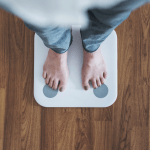As women age, their hormones begin to change. One frustrating effect is that no matter what women do, the normal contours of their body’s change too. Some women eat super healthy every day – everything organic organic organic; and dark greens like kale. Of course also antibiotic-free and free-range eggs and meats. They are even doing sports or yoga 2-3 times a week. Then there are many women who do not do this level of physical activity and who also do not consciously follow any particular diet. However, both of them will eventually face the same problem at a certain age – an extra inch around the belly.
Hence weight gain may feel like it’s inevitable once you’ve reached a certain age, but the truth is it doesn’t have to be. You don’t need to idly accept that the number on the bathroom scale will steadily creep up. Instead, you need to understand that this is all a result of your hormones fluctuating.
What’s going on is this: a woman’s body is preparing for menopause and as a result her hormone levels are fluctuating. And these hormones play a big role in both fat storage and its distribution. Before perimenopause, fat likes to hang out in the thighs, hips and buttocks. But during and after menopause? Fat gets restless and likes to move. It’s new favorite spot is the midsection.
Here are the factors that contribute to this common problem that almost all women are facing.
Estrogen Dominance
During perimenopause, women experience the first signs of the age-related hormonal decline that will eventually stop periods completely and usher in menopause. In a normal menstrual cycle, estrogen rises in advance of ovulation, then peaks and falls if the egg is not fertilized. At this point, the egg ruptures and releases progesterone, which will remain the dominant hormone for the rest of the cycle. But with the onset of perimenopause, this changes.
The estrogen to progesterone imbalance is what causes estrogen dominance, which is an excess of estrogen in the bodies. As the ovaries start to shut down, the progesterone in the lining of the ovary (corpus luteum) starts to decline first before the estrogen does. This leads to estrogen dominance and symptoms such as hot flashes, breast tenderness, and of course, the belly tire.
Many women including those of child-bearing age have an estrogen dominance problem. For example, for those women who exercise daily, it’s likely that progesterone is being used up, also leading to estrogen dominance. Other causes of estrogen dominance include environmental factors such as pesticides, plastics, industrial waste products, car exhaust, meat, soaps, furniture and carpet that produce “xenoestrogens” or “environmental estrogens.” Xenoestrogens are a class of man-made chemicals that are absorbed by the human body. They are toxic and hormone disruptive.
Increasing Stress Levels
High levels of the stress hormone cortisol is another reason why women tend to keep weight on their belly.. When too much cortisol is produced, the body goes into accelerated fat storing mode. High cortisol levels make one hungry all the time as the body thinks it needs to survive so therefore more food is needed. More fat equals more estrogen and so the vicious cycle continues. Thus, how a woman deals with stress is important for their long-term health, and reducing the belly tire. Exercise and yoga can help in decreasing levels of stress.
Slowing of Metabolism & Sleeping Issues
As women go into menopause the metabolism slows down and women lose muscle mass often due to low testosterone. So they need to eat less food just to maintain their weight. If they keep eating the same amounts, they will put on weight. Another problem is that a lack of sleep results in loss of growth hormone, which would help lose weight and gain muscle. In other words: sleep-deprived, menopausal women will have an even more difficult time losing weight, especially if they keep eating like they used to.
Unhealthy Lifestyle
There are several lifestyle factors that can also contribute to your hormonal imbalance. This includes diet, exercise, unhealthy habits like smoking, prescription medication, chemicals in cosmetics and body care products, and the environment.
Bringing hormones into balance requires addressing a range of these factors, and it takes time. It can be addressed by shifting diet, exercise, sleep, and stress management! So while it is not the sit-ups or crunches alone that are going to manage the belly tire, losing this developing belly tire as a woman ages is not an impossible task.
Youtube gif from Dirty Dancing I’m having the time of my life.
https://www.youtube.com/watch?v=WpmILPAcRQo
Scientific articles:
http://www.menopause.org/for-women/menopauseflashes/exercise-and-diet/are-you-officially-overweight-
http://www.obesitynetwork.ca/
http://www.hsph.harvard.edu/nutritionsource
http://journals.lww.com/menopausejournal/Abstract/2000/07020/A_Longitudinal_Study_of_Weight_and_the_Menopause.5.aspx









